South Sudan Media Guide 2025: Understanding South Sudan's Media Ecosystem And Viability

In a country struggling with ongoing political challenges, poor infrastructure, and low literacy rates, South Sudan's media sector faces an uphill battle for sustainability and relevance. While neighboring Kenya enjoys a vibrant and evolving media ecosystem with high connectivity rates, South Sudan presents a stark contrast, highlighting the relationship between economic development and media viability.
Traditional Media Dominance In a Digital Desert
Traditional journalism still reigns supreme in South Sudan. Walking through the streets of Juba, newspaper vendors are common. Three major national newspapers are currently in circulation: The Dawn, The Citizen, and The City Review. The oldest and once most popular newspaper, Juba Monitor, was suspended in April 2022 over disputes about legal ownership, illustrating the precarious nature of print media in the country.
Radio remains the most important and popular medium for accessing information among South Sudan's 11 million people. About a dozen radio stations operate within Juba City, including Radio Bakhita, Radio Miraya, Eye Radio, Capital FM, City FM, and Advance FM. Across the country's 10 states, approximately 26 radio stations serve local populations.
The UN-run Radio Miraya has the widest geographic reach of any FM station in the country, broadcasting from Juba and through a network of 26 relay stations linked by satellite. According to Internews surveys, in Juba city alone, 66 percent of the population have radio access, with men being more likely (70 percent) to have listened to radio than women (62 percent).
Limited Television Penetration
Television has struggled to gain traction in South Sudan, primarily hampered by economic hardship, inflation, and limited infrastructure. The state-run South Sudan Broadcasting Corporation (SSBC) is the only operational TV station in the country, mainly broadcasting pro-government content.
The use of digital satellite technology has a limited reach, with only about 10 percent of South Sudanese having access. Lack of electricity is a primary barrier to television access—according to a 2015 Internews survey, less than 29 percent of South Sudanese had at least one source of power, and only 8 percent owned television sets.
Digital Divide: One of the World's Lowest Internet Penetration
Only about 11% of South Sudan's population has access to the internet, making it one of the lowest internet penetration rates globally. This severely limits the prospects for digital media development. As of 2019, the Internet penetration rate had grown slightly to 17 percent, representing about 2.23 million users, with approximately 95 percent of the internet users accessing it through mobile phones.
Only about 1.8% of South Sudan's population has access to social media platforms. Facebook is the most used platform (80%), followed by YouTube (9%), Twitter (8%), LinkedIn (3%), Pinterest (0.4%), and Instagram (0.3%). Despite limited access, social media has played a concerning role during periods of conflict, with platforms like Facebook and WhatsApp being used to spread tribal and ethnic sentiments during both the 2013 and 2016 conflicts.
Financial Challenges And NGO Dependency
External funding dependency
For-profit media outlets rely heavily on advertisements, talk shows, and announcements from non-governmental organizations as their major revenue streams. Many media organizations depend on institutional support from NGOs, including salary payments and capital infrastructure investments.
International support
Foreign embassies and development partners such as USAID, GiZ, Swedish, and Norwegian aid organizations make substantial contributions to support media development and training.
Unsustainable Business Models
Over-reliance on international NGO funding significantly undermines sustainability. For instance, Gurtong, a once-popular website and non-profit media organization employing over 100 media practitioners across the country, closed down in 2021 when its funding diminished.
Press Freedom Concerns
Media organizations in South Sudan face significant challenges regarding freedom of expression
- Government Censorship
Media outlets are pressured to censor their content due to the strong-handedness of the National Security Services and the National Communication Authority.
- Closures and Restrictions
Over the past 10 years, more than five newspapers have closed due to harsh business conditions or government pressure. At South Sudan's independence, over 10 newspapers were circulating in the country, but most have since been shut down.
- Content Quality Issues
With slim profit margins, quality journalism remains difficult to achieve. Most newspapers run just six pages, with some stories copied and pasted from external sources.
Looking Ahead: The Path To Viability
For South Sudan's media to become viable, essential elements need continuous improvement.
- Peace and Stability: The return of sustained peace is essential for media development.
- Legal Framework Implementation: Enforcing existing media legislation and constitutional provisions that support a free press.
- Infrastructure Development: Expanding electricity access and telecommunications infrastructure.
- Literacy Programs: Addressing low literacy rates that limit newspaper readership.
- Sustainable Business Models: Developing revenue streams beyond NGO dependency.
- Digital Integration: Gradually expanding digital access as infrastructure improves.
A thriving media ecosystem highlights how economic development, infrastructure, and policy frameworks influence media viability. As South Sudan continues its development journey, strengthening its media sector will be essential for national growth, public discourse, and democratic accountability.
Get South Sudan's comprehensive media insights here